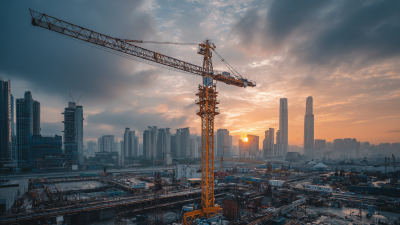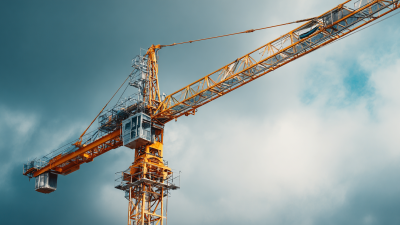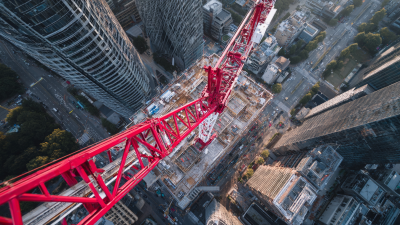In the rapidly evolving realm of modern construction, maximizing efficiency is paramount, and tower cranes have emerged as indispensable assets that significantly enhance project outcomes. According to a recent report by the Construction Industry Institute, effective crane usage can reduce project timelines by up to 30%, demonstrating the critical role that tower cranes play in streamlining operations. Furthermore, the global tower crane market is projected to reach $3.8 billion by 2027, driven by increasing urbanization and the rising demand for high-rise buildings.

Renowned industry expert Dr. James Harwood, a leading authority on construction equipment optimization, emphasizes the importance of tower cranes in contemporary projects, stating, “The integration of tower cranes not only boosts productivity but also elevates safety standards, paving the way for innovative construction methodologies.” This innovation is particularly evident in complex urban environments where spatial limitations challenge traditional construction techniques. As the construction sector continues to evolve, the strategic deployment of tower cranes is set to redefine project execution and ultimately transform the landscape of modern architecture.
Tower cranes play a crucial role in enhancing construction efficiency, addressing the growing demands of modern engineering projects. According to the American Society of Civil Engineers, using tower cranes can reduce project timelines by up to 30%, significantly accelerating the construction process. Their design allows for lifting heavy materials to substantial heights, enabling multi-storied buildings to rise quickly and safely. By minimizing the number of lifts needed through their extended reach and capacity, tower cranes contribute to a smoother workflow and less downtime on construction sites.
Tip: When planning a construction project, consider the height and reach of the tower crane, as this directly impacts its efficiency. Proper site layout and logistics can further increase the crane's productivity by minimizing movement and maximizing load delivery.
Moreover, integrating tower cranes into project planning enhances safety and reduces labor costs. With advanced technology, many modern tower cranes are equipped with sensors and automation features that ensure precise lifting and placement, thereby minimizing the risk of accidents. A report from the International Journal of Engineering and Technology highlights that construction sites using tower cranes see a 50% reduction in workplace injuries, showcasing the cranes' role not only in efficiency but also in safeguarding workers.
Tip: Regular maintenance and operator training are essential to ensure tower cranes function effectively and safely, thereby maximizing their potential on site.
Tower cranes play a pivotal role in modern construction projects, enhancing productivity through several key features. One of their most significant advantages is their vertical lifting capacity, allowing them to reach impressive heights while maximizing horizontal reach. This capability is essential in urban environments where space is limited, enabling the efficient movement of materials and equipment, which accelerates project timelines. Additionally, the modular design of tower cranes facilitates easy assembly and disassembly, resulting in reduced downtime between construction phases.
Recent industry insights indicate that the tower crane rental market is projected to reach USD 22.1 billion by 2030, highlighting the increasing reliance on these machines in large-scale projects. Their utilization is also reflected in ongoing infrastructure developments, such as the five advanced tower cranes currently deployed in a $3-billion subway extension project in Canada, underscoring their critical role in facilitating complex urban construction. As demand for efficient construction solutions rises, the market for tower cranes is expected to continue its steady growth, reaching USD 36,971.1 million, driven by robust infrastructure initiatives across North America, Europe, and Asia.
Tower cranes play a pivotal role in modern construction, and operating them safely and effectively is critical, especially in light of the challenging market conditions. With the global market for load moment indicators projected to reach $1.13 billion by 2033, the emphasis on safety protocols is more relevant than ever. Given a steep decline in tower crane sales—from 5,000 units in 2020 to just 2,334 in the first part of 2025—construction companies must prioritize best practices to maximize efficiency while minimizing risks.
Best practices for operating tower cranes encompass thorough training for operators, regular maintenance checks, and adherence to safety regulations. Operators should be well-versed in handling the rigors of extreme weather conditions, as demonstrated by recent high-rise projects in Russia, where cranes successfully navigated challenging environments to construct some of Europe’s tallest buildings. Implementing systematic safety measures not only improves operational efficiency but also protects the workforce, ensuring that projects can proceed smoothly even amidst market fluctuations.
| Project Name | Location | Budget (in million $) | Completion Time (months) | Height of Crane (meters) | Key Benefits |
|---|---|---|---|---|---|
| Skyline Tower | New York, USA | 150 | 24 | 50 | Increased lifting speed, reduced labor costs |
| Golden Gate Bridge Expansion | San Francisco, USA | 200 | 18 | 65 | Improved safety and efficiency |
| Eco Tower | London, UK | 100 | 20 | 40 | Reduced energy consumption |
| Downtown Highrise | Toronto, Canada | 250 | 30 | 75 | Enhanced material handling |
| River View Estates | Sydney, Australia | 180 | 22 | 55 | Faster project completion |
In the realm of modern construction, the integration of tower cranes with advanced technology is pivotal in maximizing efficiency. Tower cranes have evolved beyond traditional lifting mechanisms, incorporating smart technologies that enable real-time data analysis and enhanced operational control. This technological synergy allows project managers to monitor crane performance, optimize load handling, and streamline workflows, ultimately reducing downtime and increasing productivity on site.
Furthermore, the usage of digitally controlled tower cranes equipped with GPS and telematics provides contractors with detailed insights into project progress. This integration facilitates better planning and coordination among various teams, ensuring that resources are allocated effectively and tasks are completed in a timely manner. Additionally, innovative safety features that leverage technology help to minimize risks associated with crane operation, protecting both workers and equipment. By harnessing the power of modern technology, the capabilities of tower cranes continue to transform construction projects into examples of efficiency and precision.
Tower cranes have become essential in modern construction, providing a significant advantage over traditional lifting equipment. Their design allows for greater reach and versatility, enabling construction teams to lift heavy materials to towering heights with precision. Unlike older equipment, which often requires extensive space and multiple setups, tower cranes are more efficient in confined job sites, minimizing the time and resources needed to complete projects. Their ability to rotate 360 degrees and adapt to various construction layouts further enhances their operational efficiency.
In a comparative analysis, tower cranes demonstrate superior capabilities when juxtaposed against traditional lifting machinery like hoists or mobile cranes. While traditional equipment may have limitations in height and load capacity, tower cranes can lift substantial loads over existing structures without the need for repositioning. This adaptability not only accelerates project timelines but also reduces labor costs associated with multiple lifts and equipment setups. As the construction industry increasingly embraces innovation and efficiency, tower cranes are solidifying their position as the preferred choice for modern construction projects, heralding a new era in the building process.








